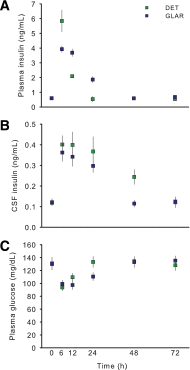Insulin Detemir Is Transported From Blood to Cerebrospinal Fluid and Has Prolonged Central Anorectic Action Relative to NPH Insulin
- PMID: 25667307
- PMCID: PMC4477354
- DOI: 10.2337/db14-1364
Insulin Detemir Is Transported From Blood to Cerebrospinal Fluid and Has Prolonged Central Anorectic Action Relative to NPH Insulin
Abstract
Insulin detemir (DET) reduces glycemia comparably to other long-acting insulin formulations but causes less weight gain. Insulin signaling in the brain is catabolic, reducing food intake. We hypothesized that DET reduces weight gain, relative to other insulins, owing to increased transport into the central nervous system and/or increased catabolic action within the brain. Transport of DET and NPH insulin into the cerebrospinal fluid (CSF) was compared over several hours and after the administration of different doses peripherally in rats. DET and NPH had comparable saturable, receptor-mediated transport into the CSF. CSF insulin remained elevated significantly longer after intraperitoneal DET than after NPH. When administered acutely into the 3rd cerebral ventricle, both DET and NPH insulin reduced food intake and body weight at 24 h, and both food intake and body weight remained lower after DET than after NPH after 48 h. In direct comparison with another long-acting insulin, insulin glargine (GLAR), DET led to more prolonged increases in CSF insulin despite a shorter plasma half-life in both rats and mice. Additionally, peripheral DET administration reduced weight gain and increased CSF insulin compared with saline or GLAR in mice. Overall, these data support the hypothesis that DET has distinct effects on energy balance through enhanced and prolonged centrally mediated reduction of food intake.
© 2015 by the American Diabetes Association. Readers may use this article as long as the work is properly cited, the use is educational and not for profit, and the work is not altered.
Figures






References
-
- Baskin DG, Woods SC, West DB, et al. . Immunocytochemical detection of insulin in rat hypothalamus and its possible uptake from cerebrospinal fluid. Endocrinology 1983;113:1818–1825 - PubMed
-
- van Houten M, Posner BI. Insulin binds to brain blood vessels in vivo. Nature 1979;282:623–625 - PubMed
-
- Banks WA. The source of cerebral insulin. Eur J Pharmacol 2004;490:5–12 - PubMed
Publication types
MeSH terms
Substances
Grants and funding
LinkOut - more resources
Full Text Sources
Other Literature Sources
Medical

